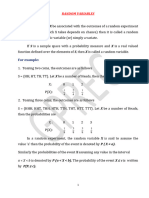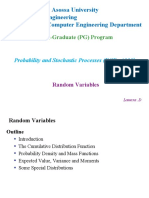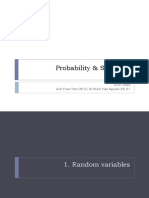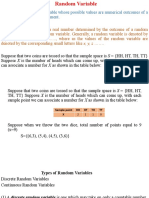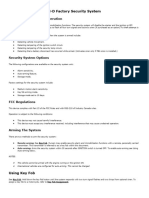CHAPTER 3: RANDOM VARIABLES
3.1 Introduction
Random variable assigns a numerical value to each
outcome of a random experiment.
Random Variable Possible
values
X= Number of defectives in a random
sample of two computer chips drawn X=0, 1, 2
from a shipment
X= the waiting time until the first
customer arrives at a checkout counter X 0,8
(the counter will be open for 8 hours).
The probability distribution of a random variable X tells
us what the possible values of X are and how probabilities
are assigned to those values.
Types of Random Variables:
Discrete: possible values are isolated points on the number
line (number of defectives in a sample).
Continuous: possible values lie in an interval (waiting
time, time, temperature, pressure).
1
�3.2 Discrete Random Variables
Probability Mass Function
Probability mass function of a discrete random variable X
is the function p(x) = P(X=x). The probability mass
function is also called the probability distribution.
The probability mass function (probability distribution) of a
discrete random variable is specified by a table:
x x1 x2 ... xn
P(X=x) p1 p2 ... pn
Here xi are the possible values of X and pi the
corresponding probabilities (sum of pi values equal to 1).
Example 1: Number of defectives
10% of computer chips in a very large shipment are
defective. Denote by X the number of defective chips in a
random sample of two. Find the probability distribution of
X. What is P(X1)?
Solution:
2
�Graph of the probability mass function:
0.81
0.18
0.01
0 1 2 x
The heights of the three vertical line segments represent
probabilities assigned to the three possible values of X. The
total probability is equal to 1.
Cumulative Distribution Function
The cumulative distribution function F(x) of a discrete
random variable X is
F ( x) P( X x) Sum of probabilities pi for xi x
p1 p2 p3 pn
x1 x2 x3 . x xn
3
�Example 2: Obtain the cumulative distribution function
F(x) for the random variable X from the previous example.
Solution:
Mean and Variance
Example: X=number of calls taken by a switchboard
within 1 minute
X 0 1 2 3 4
Fraction 0.31 0.39 0.18 0.11 0.01
Average number of calls =?
4
�The mean or expected value of a discrete random variable
X, denoted as E(X) or is
E ( X ) pi xi ,
i
The expected value E(X) is a measure of the average value
taken by X.
The variance of X, denoted as Var(X) or 2, is
Var ( X ) ( xi ) 2 pi .
i
The variance Var(X) measures the spread of X about its
mean value. The standard deviation of X is .
2
Equivalent Formula:
Var ( X ) xi2 pi 2 .
i
Example 3: Calculate the mean and standard deviation of
X=the number of defectives in a random sample of two.
5
�Example 4: Suppose that someone offers you bet of
flipping two fair coins. If two heads are obtained, you win
$10, otherwise you must pay $6. What are your expected
winnings?
6
�3.3 Continuous Random Variables
Probability Distributions for Continuous Variables
Example: X = Weight of women in a population
Area=fraction of women of
weight between 129 and 130
Relative
Freq.
Total area of all rectangles = 1
129 130 X
Area=fraction of women
of weight smaller than 130
Relative
Freq.
129 130 X
distribution of X approximated
by a smooth curve (density
curve)
Relative
Freq.
7
� Density curve describes
the overall pattern of a
Relative distribution
Freq.
Total area under the
curve = 1
Relative
Freq.
Area = proportion of
observations between a and b
Probability distribution of a continuous random variable
is specified by a function f(x) called, the density curve,
such that
(a) f ( x) 0,
(b)
f ( x)dx 1,
b
(c) P(a X b) f ( x)dx.
a
8
� f (x)
P(aXb)
a b
P(aXb) = Probability that the values of X are between
a and b = Area under the density curve of X between a
and b.
The area under the entire graph of f(x) is 1.
P(X=x) = 0 for any value x of X.
Example 5: Shapes of Density Curves
Density curve of a right
skewed distribution
Density curve of a left
skewed distribution
9
� Density curve of a
uniform distribution
0 1
uniformly distributed between 0 and 1
Example 6: Suppose that f(x) = kx2 for 0<x<1 and
f(x)=0 otherwise.
(a) Determine the constant k so that f (x) is a
probability density of X.
(b) Calculate P(0<X<0.5)
(c) Determine x such that P(X<x)=0.5
10
�The cumulative distribution function F(x) of a
continuous random variable X is
x
F ( x) P( X x)
f (t )dt.
for -<x<.
f (x)
F(x) = Area to the left of x
F(x) tends to 1 as x tends to , F(x) increasing function.
Conclusions:
1. The density function f(x) is the derivative of F(x):
dF ( x)
f ( x) ,
dx
2. The probability
P(aXb) = F(b)-F(a).
11
� P(aXb)
a b
F(b)
F(a)
Example 7: Obtain the cumulative distribution function
for the density function specified in the previous
example. Obtain P(X<0.5) and P(0.25 < X < 0.75) using
the cumulative distribution function.
Solution:
12
� Mean and Variance
The mean or expected value of X, denoted as E(X) or is
E( X ) x f ( x)dx.
The variance of X, denoted as Var(X) or 2 is
2 Var ( X ) 2
( x ) f ( x)dx.
The standard deviation of X is .
2
Equivalent Formula:
2
x 2 f ( x)dx 2 .
Example 8: A random variable X follows a uniform
distribution in the interval (0, 1). Obtain the mean and the
standard deviation of X.
Solution:
13
�Example 9: Consider f(x)=3x2 for 0<x<1 and f(x)=0
otherwise. Obtain the mean and the variance of X.
Solution:
14
� Median and Percentiles
The median of X is the point x such as
F ( x) P( X x) 0.5.
x
Area = 0.50
If p is any number between 0 and 1, the 100pth percentile
is the point x such as
F ( x) P( X x ) p.
f (x)
x
Area = p
15
�The median is the 50th percentile. The lower quartile (Q1 ) is
the 25th percentile and the upper quartile (Q3) is the 75th
percentile. The interquartile range IQR= Q3 Q1.
Example 10: Obtain the median and the interquartile range
for the random variable X with the density function
f(x)=3x2 for 0<x<1 and f(x)=0 otherwise. What is the 10th
percentile?
Solution:
16
�3.5 Mean and Variance of a Linear Combination
Linear Function of a Random Variable
X a aX
Multiply all values of X by a constant a
If X is a random variable, and a and b are constants, then
E (a X b) a E ( X ) b,
Var (a X b) a 2 Var ( X ).
Conclusion: Suppose the random variable X has the
mean and the standard deviation . Then the random
variable
X
Y ,
has the mean of 0 and the standard deviation of 1.
Two random variables are said to be independent if the
value taken by one is not related to the value taken by the
other random variable.
17
� Sums of Random Variables
1 X1 2 X2 1 2 X1+X2
Add all values of X1 to all values of X2
If X1 , X2 are random variables with the means E(X1)
and E(X2 ) then
E(X1 +X2)= E(X1) +E(X2).
If X1 , X2 are independent random variables,
Var(X1 +X2)= Var(X1) +Var(X2).
Linear Combination of Random Variables
If X1 , X2 , , Xn are random variables with the means
E(X1), E(X2), , E(Xn) then
E(a1X1 +a2X2++ anXn+b)= a1E(X1) +a2E(X2)++
+anE(Xn)+b,
18
� for any constants a1 , a2 , , an and b.
If X1 , X2 , , Xn are independent random variables with
the variances Var(X1), Var(X2), , Var(Xn) then
Var(a1X1 +a2 X2 +...+ an Xn +b)= a12 Var(X1 )+a22 Var(X2 )+...a 2n Var(Xn ).
for any constants a1 , a2 , , an and b.
Example 11: Suppose the weights of people who use an
elevator follow a random variable with the mean of 69 kg
and standard deviation 9 kg.
(a) Find the mean of the total weight of 30 randomly
selected people in the elevator.
(b) Find the standard deviation of the total weight of 30
randomly selected people in the elevator.
19







